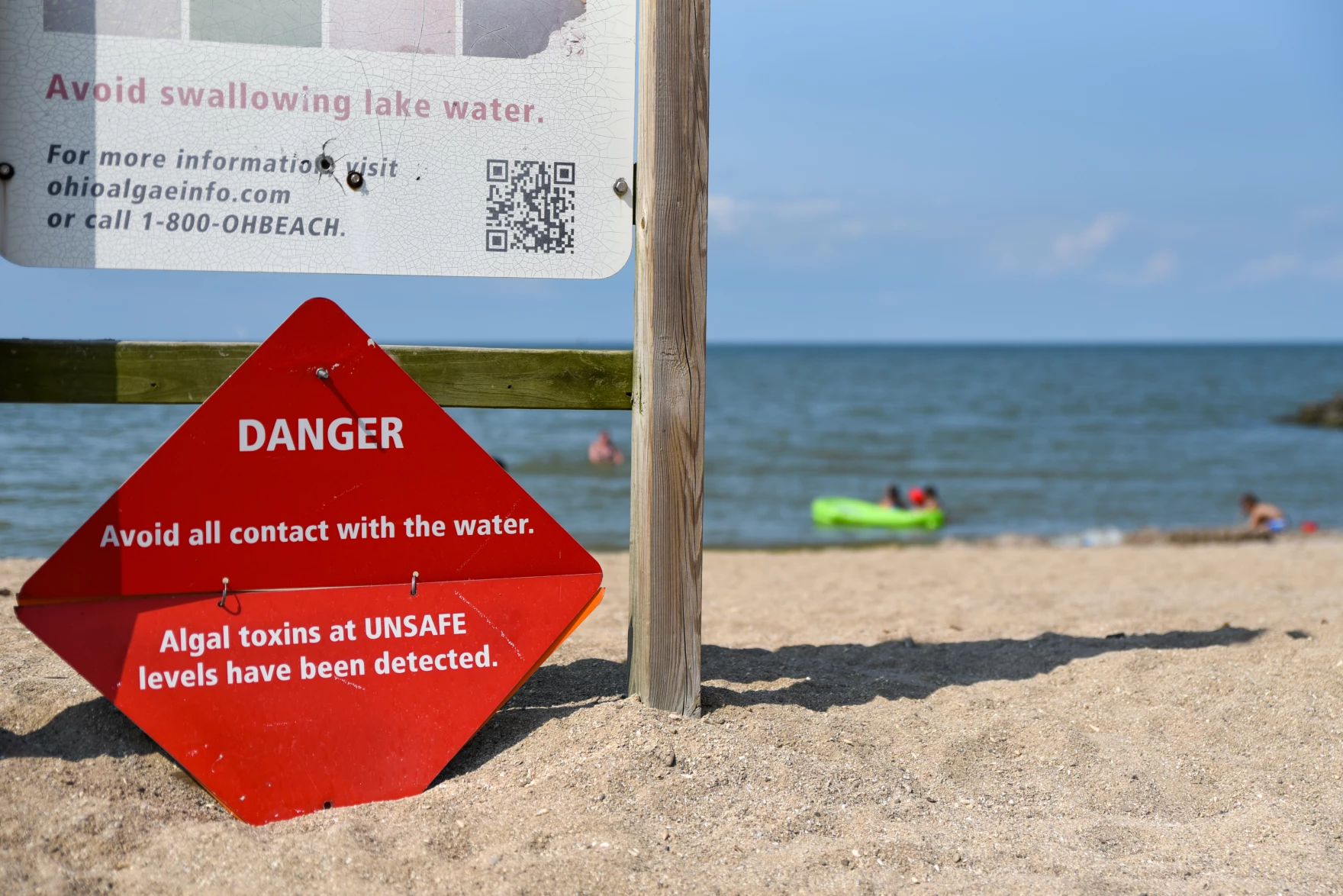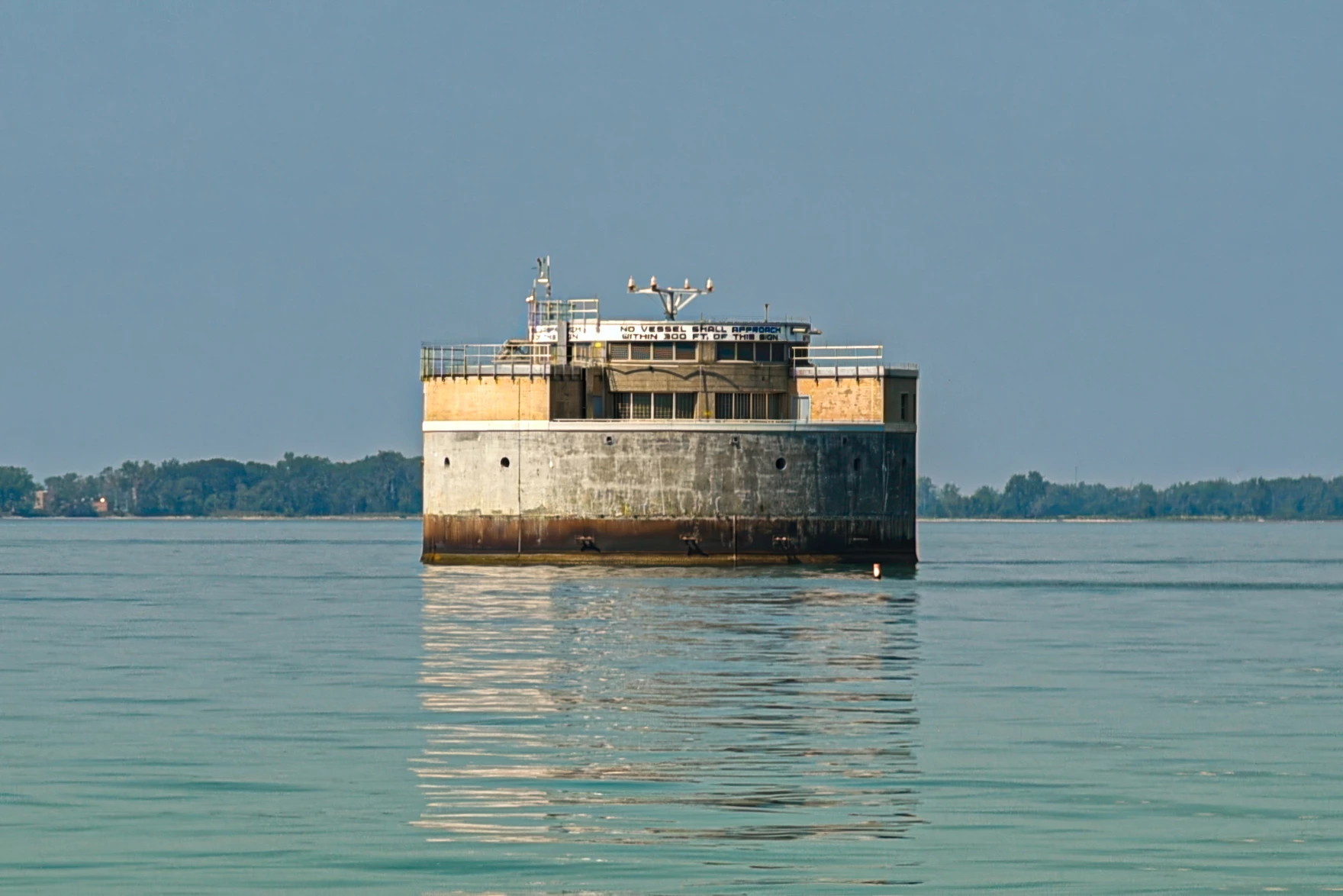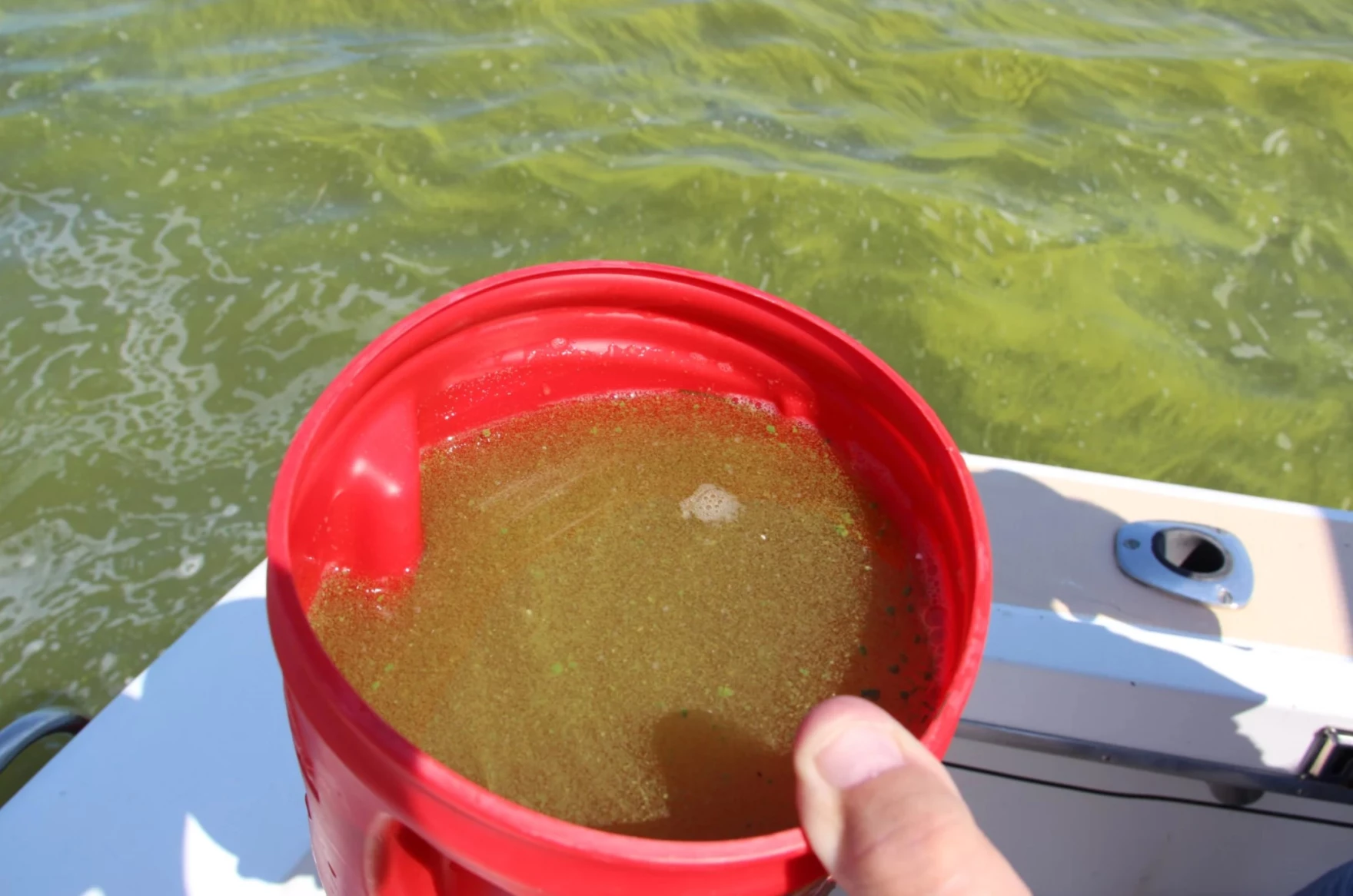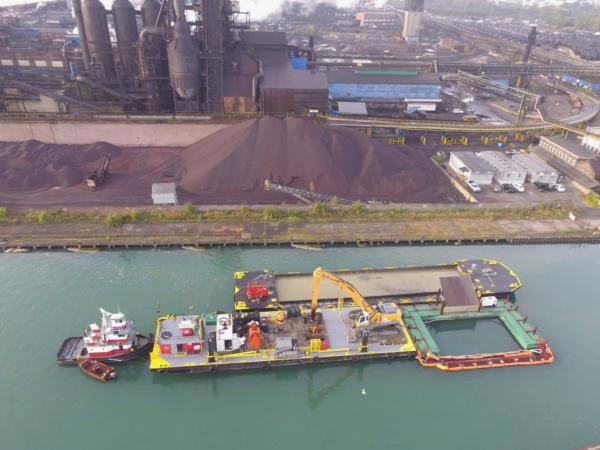
By Lester Graham, Michigan Public
On a hot summer day in July, children and adults are playing in the water at Maumee Bay State Park on Lake Erie. Up and down the beach are large red signs with white lettering, reading: “Danger. Avoid all contact with the water. Algal toxins at unsafe levels have been detected.” Families walked past them and waded in.
A nearby drainage ditch which leads to Lake Erie looks as though someone spilled green paint on the surface. That paint is actually a cyanobacterial bloom, the source of microcystins, the toxins that are in the water where families are splashing.
Ten years ago, as a precautionary measure, Toledo issued a ‘do not drink’ order for its water system because a toxic bloom had formed around it’s water intake structure in Lake Erie. Water was shut off to nearly a half million people in Ohio and Michigan for three days.
To many, it was a surprise. Toxic blooms like these used to happen decades ago. But, that was before the Clean Water Act went into effect, reducing some of the causes of the cyanobacterial blooms.
“We took phosphorus out of laundry detergents, cleaned up wastewater treatment and industry and so on. And that led to an era of improvement in the 1980s and 90s,” said Tom Bridgeman, a professor of ecology and Director of the University of Toledo Lake Erie Center.

Tom Bridgeman, Director of the University of Toledo’s Lake Erie Center, explains one of the experiments on water samples taken from Lake Erie. The three containers on the left are the original samples. The three on the right show the results of adding phosphorus and nitrogen three days later. (Lester Graham/Michigan Public)
But then farming practices changed. During the Reagan administration, Secretary of Agriculture Earl Butz told farmers to “get big or get out.” Farmers were told to plow from fence row to fence row, ditch to ditch. More land was planted in corn, soybeans, and wheat. Over time, agriculture became more industrialized. Chemical fertilizers and large concentrated animal feeding operations contributed to the higher amounts of nutrients getting into the water, feeding the cyanobacterial blooms in western Lake Erie.
Farms were not the only sources of the nutrients, but because of the largely agricultural watersheds feeding the lake, they were by far the biggest contributors of phosphorus and nitrogen into Lake Erie.
The news of the Toledo water system shutdown was a shock to many people in the region. People took safe, clean water for granted. The Toledo water crisis was reported widely.

Gregory Dick is Director of the Cooperative Institute of Great Lakes Research (CIGLR) at the University of Michigan. He’s concerned about climate change effects because cyanobacteria thrive in hotter weather. (Lester Graham/Michigan Public)
“2014 made all the headlines because the highly toxic bloom that was near the drinking water intakes. But, there were also really big blooms in 2011, 2015, and 2019. So, the good news is that we haven’t seen those really large blooms in the last few years. But, the bad news is we’re still way above what I think anyone would consider acceptable,” said Gregory Dick, Director of the Cooperative Institute of Great Lakes Research (CIGLR) at the University of Michigan.
It cost a half-billion dollars to make the Toledo water plant safe from the toxins.
The total cost in making drinking water safe in the wider Toledo area is estimated to be double that, a one billion dollar price tag paid by taxpayers and Toledo area water customers.
“I think the good news is that nothing like Toledo is going to happen again, at least in the western basin of Lake Erie. We have safeguards in place to prevent that sort of crisis from happening,” said Dick.
But the price tag is still going up. A small army of regulators and researchers are studying the causes of the cyanobacterial blooms and the specific health risks of the toxins. Federal and state environmental, agricultural, and conservation agencies, Ohio State University, the University of Michigan, the University of Toledo, Bowling Green State University, the Sea Grants of Ohio and Michigan, and others are researching different aspects of the problem. They’re working on projects to reduce the nutrient load through better farming practices, wetland restoration, and other work on the ground. Non-profit conservation groups are lending expertise. Some have close relationships with the farming community. It is a huge effort, but then, the job is massive.
The causes are fairly simple. Phosphorus feeds the cyanobacterial blooms. Nitrogen helps make the toxic varieties more toxic. Reducing the amount of those nutrients getting into Lake Erie is the goal.
Why doesn’t the government stop the pollution?
A question that’s asked is: If the more than 50 year-old Clean Water Act reduced phosphorus and other nutrients decades ago, why can’t it be used to reduce the fertilizer pollution that runs off farm fields and into ditches and streams that ultimately lead to Lake Erie?
“The Clean Water Act is just simply not designed to address those problems directly, and it doesn’t give authority to the EPA to address them directly,” said Evan Zoldan, professor of law and Director of the Legal Institute of the Great Lakes, at the University of Toledo Law Center.

Evan Zoldan is professor of law and director of the Legal Institute of the Great Lakes, at the University of Toledo Law Center. (Lester Graham/Michigan Public)
In the 1970s, the biggest source of water pollution came from factory pipes. Trace back the source of the pipe, and you knew what company was responsible.
“And since the Clean Water Act regulates what we call ‘point sources’ of pollution, it does not directly regulate what we call non-point sources of pollution,” Zoldan explained.
Runoff from agricultural fields is a non-point source of pollution.
Zoldan said state regulators such as the Ohio Department of Natural Resources and the Michigan Department of Environment, Great Lakes, and Energy also have limited authority. They don’t have the legal means to regulate farm runoff unless it’s been shown to have caused immediate damage to the environment such as a fish kill.
He emphasized that he doesn’t believe there’s a single policy or a single regulation that is going to solve all of the regulatory issues necessary to reduce the nutrient pollution getting into Lake Erie from Ohio and Michigan rivers.
One regulatory body that might have the necessary clout was created by Congress in 2022. It’s called the Great Lakes Authority. But, it’s unclear how much of a priority Lake Erie’s nutrient pollution problem will be for the new entity.
Zoldan said another tool that’s being considered is something like the market-based cap and trade programs being used to offset carbon pollution.
“Let’s figure out what is the amount of nutrients that wouldn’t be a problem. And then cap the total amount, region wide, at a certain amount, and then let there be a market, and encourage there would be a market for the different producers to produce no more than a certain amount of nutrients each.”
Cap and trade schemes can work, but they’re not always well regulated.
What can be done to reduce nutrient pollution now?
Ohio and Michigan, as well as Canada, agreed to take measures to reduce nutrient pollution flowing into the western basin of Lake Erie by 40 percent. Ohio and Michigan are to meet that goal by next year. They won’t.
At a Michigan conference in December a state official was asked what the new target date might be. He said that’s an excellent question. “Ask me again in five years and we’ll see.”
At the University of Toledo’s Lake Erie Center, Director Tom Bridgeman said this is all about money.
“And we’re going to pay one way or another. We’re either going to pay to clean up our drinking water, which costs tens of millions or more per year, or we’re going to pay to prevent the bloom in the first place. We’re going to have to pay, because right now Lake Erie is paying and that, that can’t continue.”
Ohio and Michigan are paying farmers incentives to help reduce the runoff, paying them to use different methods of applying fertilizer, to plant buffer strips between fields and ditches or creeks, and other remedies. The state’s are trying to restore wetlands to help filter out nutrients before they reach the lake.
“But still, at this point, we’re not seeing the reduction in nutrients coming off the land. And we’re not seeing a reduction in blooms in Lake Erie yet,” Bridgeman said.

The Toledo water intake crib in Lake Erie. (Lester Graham/Michigan Public)
At the University of Michigan, Gregory Dick said the big challenge is that there’s really “no mechanism to hold polluters accountable, to hold farmers accountable.”
And Dick said as time goes on, it’s only going to get more complicated.
“It’s kind of a moving target in a way, because even if you’re reducing the amount of fertilizer on the field, climate change erases some of the gains we’re making.”
That’s because more intense storms fueled by climate change wash more fertilizer nutrients from the field and into the ditches, streams, and rivers that flow into Lake Erie.
Are these toxins a real health threat?
The quick answer is: Yes, the toxins are a health threat. What’s less clear is who is most vulnerable.
Dr. Steven Haller, is an associate professor of medicine at the University of Toledo. He said research on exposure through ingestion, dermal exposure, and lung exposure to airborne toxins are underway.

Dr. Steven Haller explaining lab research into the effects of toxins from cyanobacterial blooms on human health. (Lester Graham/Michigan Public)
One of the at risk groups is people who have preexisting liver disease, because the cyanobacteria’s toxins, microsystin, will attack the liver.
“We had an experimental model of liver disease, called nonalcoholic fatty liver disease, which is fairly common. And in that model, when we expose that model to microcystin, we saw changes in the liver, inflammatory changes, changes in the structure of the tissue, increases in inflammation, increases in circulating markers of inflammation. So we actually showed markers, of that liver disease actually got worse following exposure to microcystin,” Dr. Haller said.
Researchers are just beginning to look at possible health risks of exposure to skin.
Aerosolization of the toxins is another area of study.

University of Michigan Professor of Chemistry Andrew Ault is researching whether harmful algal bloom toxins are aerosolized and possibly breathed in by people on or near Lake Erie. (Lester Graham/Michigan Public)
At the University of Michigan, Andrew Ault is looking into that. He is an associate professor of chemistry. Last year he explained why his greatest concern is those toxins becoming airborne.
“If you breathe in the toxin, it’s much more -about a thousand times more harmful than if you drink it, just because our lungs are much more sensitive. Whereas, our digestive tracts are a little bit more used to handling the rough stuff,” Ault explained.
A windy day can mean people at the beach can be exposed to droplets of water containing toxic microcystin.
Dr. Haller at Toledo University has begun research into that kind of exposure.
“So when you think of waves crashing or a jet ski going through the lake, it can stir this stuff up, and now you have toxins that are getting released out in the air.”
Haller said experiments in the lab did show markers of inflammation of lung tissue increase. That might mean people with asthma might be affected more than the general public.
But they need to better understand what’s happening outside of the lab. They need to see how much microcystin is becoming airborne in a real world situation.
Soon air samplers will be arriving to find out.
“We’re going to have one stationed out at the Lake Erie Center,” Haller said. There will also be a mobile sampler that can be taken to sites along the Lake Erie coast and on some inland lakes where cyanobacterial blooms have occurred.

A container of water and cyanobacteria in a photo taken by Mark Brush in 2014. (Mark Brush/Michigan Public)
It’s been ten years since questions about health risks were brought to the attention of the public because of the Toledo water crisis. Steven Haller said there’s a simple answer to why research is not farther along than it is.
“The blunt answer is money. These things are just really expensive. The studies are very expensive. Human studies take a lot of time.”
They needed federal grants. That application process also takes a long time, although it’s paid off and the research is supported.
Haller said there’s also concern that they thoroughly understand any risks. They don’t want to alarm people unnecessarily.
But he believes public engagement should inform people that they should take some precautions.
“If people are just walking by the signs on Maumee Bay State Park that say stay our of the water, it’s not safe. People will walk right by that and wander into the water. So, we need to do a better job at getting out into the community,” Haller said.
He added the big message now is just stay away. “If it’s green, don’t go near it.”
Catch more news at Great Lakes Now:
How much can wetland restoration reduce farm fertilizers getting into Lake Erie?
Why some municipalities are looking at putting solar panels on water
Featured image: Despite warnings, children and adults play in the water at Maumee Bay State Park on Lake Erie near Oregon, Ohio. (Lester Graham/Michigan Public)



